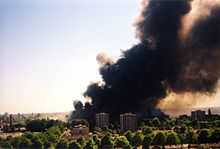Enschede fireworks disaster

The Enschede fireworks disaster (known in the Netherlands as the Vuurwerkramp meaning "fireworks disaster") was a catastrophic fireworks explosion occurring at the SE Fireworks depot on 13 May 2000, in the eastern Dutch city of Enschede.
The fire led to an enormous explosion which killed 23 people including four firefighters, and injured 947.[1] 400 homes were destroyed and 1500 buildings damaged. The first explosion had a strength in the order of 800 kg TNT equivalence, while the strength of the final explosion was within the range of 4000–5000 kg TNT.[2] The biggest blast was felt up to 30 kilometres (19 mi) from the scene.
SE Fireworks was a major importer of fireworks from China and supplier to pop concerts and major festive events in the Netherlands. Prior to the disaster it had a good safety record and met all safety audits.[3]
Dutch Television interrupted transmission of the Eurovision Song Contest 2000 midway through the programme, to show breaking news coverage. Dutch telephone voting in the contest was also suspended to free up capacity for the emergency services communications.
Damage
A 40-hectare (100 acres, or 0.4 square kilometre) area around the warehouse was destroyed by the blast.[4] Around 400 houses were destroyed, 15 streets incinerated and a total of 1,500 homes damaged, leaving 1,250 people homeless, essentially obliterating the neighbourhood of Roombeek. Ten thousand residents were evacuated, and damages eventually exceeded €450 million.[5]
Cause
It appeared that the fire began in the work area of the central building where some 900 kg of fireworks were stored. This fire then extended to two full containers that had been stored illegally outside of the building. The fireworks bunker ignition caused the explosion of 177 tons of fireworks,[6] virtually destroying the area.
One theory for the scale of the disaster was that workers had accidentally left open internal fire doors which might have contained the fire and subsequent blast. Theoretically such an explosion was considered highly unlikely because the fireworks were stored in bunkers specifically designed to minimize risk.
One week prior to the explosion, SE had been audited and met all official safety regulations and the fireworks had been legally imported and inspected as safe by Dutch authorities. Many residents from affected Roombeek—a poor, working-class neighbourhood—complained of governmental neglect and deliberate non-interest and inaction, arguing the whole disaster was an accident waiting to happen.[3]
Legal proceedings
The cause of the fire has never been officially verified. One possibility was arson, with several arrests being made by the Dutch police, but the fire department stated that accidental ignition via an electrical short circuit could not be totally ruled out.
In April 2002, the two managers of the company, Rudi Bakker and Willie Pater, were sentenced to fifteen months' imprisonment for violation of environmental and safety regulations and dealing in illegal fireworks. They were found guilty as well of an explosion with deadly consequences due to criminal negligence.
In May 2003 Arnhem Appeals Court acquitted 36-year-old André de Vries of arson. Almelo Court had originally (May 2002) tried and convicted de Vries of arson and sentenced him to 15 years imprisonment.[7]
A total of €8.5m in compensation was awarded to the victims of the Enschede firework factory explosion according to the organisation in charge of distributing the compensation, the UPV, having assessed 3,519 claims. Three hundred people received cash for incurring extra costs, 136 people received money for loss of income, and 1,477 people received compensation for health problems.[8]
Dutch fire safety regulations

The SE Fireworks disaster has led to intensified safety regulations in the Netherlands concerning storage and sale of fireworks. The Roombeek area that was destroyed by the blast has since been rebuilt.
Memorials
There have been annual public memorial services in Roombeek since 2000 led by the mayor Jan Mans, and commonly ending on the Stroinksbleekweg. The theme of 2004 was "homecoming".[7]
See also
References
- ↑ Firework Disaster Enschede 13 May 2000
- ↑ T. Bedford, P. H. A. J. M. van Gelder, 2003, "Safety and reliability: proceedings of the ESREL 2003 European safety and reliability conference", p.1688
- ↑ 3.0 3.1 Castle, Stephen (15 May 2000). "After 400 homes and 15 streets are incinerated by firework blast, the Dutch ask: Was it arson?". The Independent (London). Retrieved 2 May 2010.
- ↑ (Dutch) Volkskrant.nl
- ↑ (Dutch) ND.nl
- ↑ Online Oosting zag iets over het hoofd in Enschede, NRC Handelsblad, 23 March 2001
- ↑ 7.0 7.1 Expatica.com, accessdate 17 April 2009
- ↑ "Dutchnews.nl". Dutchnews.nl. 2007-09-19. Retrieved 2014-07-09.
External links
| Wikimedia Commons has media related to Enschede fireworks disaster. |
- Video of the explosion
- In pictures: Firework blaze – BBC News
- Satellite Map Imagery – Google Maps